Related Research Articles

Nazi Germany used six extermination camps, also called death camps, or killing centers, in Central Europe during World War II to systematically murder over 2.7 million people – mostly Jews – in the Holocaust. The victims of death camps were primarily murdered by gassing, either in permanent installations constructed for this specific purpose, or by means of gas vans. The six extermination camps were Chełmno, Belzec, Sobibor, Treblinka, Majdanek and Auschwitz-Birkenau. Extermination through labour was also used at the Auschwitz and Majdanek death camps. Millions were also murdered in concentration camps, in the Aktion T4, or directly on site.

The Romani Holocaust or the Romani genocide was the planned effort by Nazi Germany and its World War II allies and collaborators to commit ethnic cleansing and eventually genocide against European Roma and Sinti peoples during the Holocaust era.

The Holocaust—the murder of about six million Jews by Nazi Germany from 1941 to 1945—is the best-documented genocide in history. Although there is no single document which lists all Jewish victims of Nazi persecution, there is conclusive evidence that about six million were murdered. There is also conclusive evidence that Jews were gassed at Auschwitz-Birkenau, the Operation Reinhard extermination camps, and in gas vans, and that there was a systematic plan by the Nazi leadership to murder them.

Drancy internment camp was an assembly and detention camp for confining Jews who were later deported to the extermination camps during the German occupation of France during World War II. Originally conceived and built as a modernist urban community under the name La Cité de la Muette, it was located in Drancy, a northeastern suburb of Paris, France.
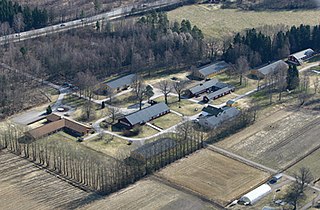
Berg interneringsleir was a concentration camp near Tønsberg in Norway that served as an internment and transit center for political prisoners and Jews during the Nazi occupation of Norway.
Leo Eitinger was a Norwegian psychiatrist, author and educator. He was a Holocaust survivor who studied the late-onset psychological trauma experienced by people who went through separation and psychological pain early in life only to show traumatic experience decades later. He devoted a long period studying posttraumatic stress disorder among Holocaust survivors, which had led Holocaust survivors including Paul Celan (1920–1970), Primo Levi (1919–1987) and many others to commit suicide several decades after the experience. Eitinger was a pioneer of research into psychological trauma among refugees, and also laid the foundation for Norwegian military psychiatry research with emphasis on psychological trauma among soldiers.
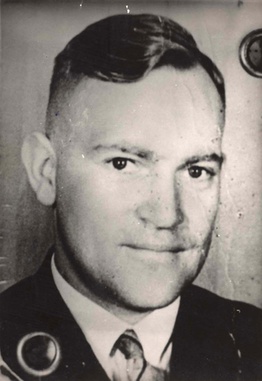
Horst Schumann was an SS-Sturmbannführer (major) and medical doctor who conducted sterilization and castration experiments at Auschwitz and was particularly interested in the mass sterilization of Jews by means of X-rays.
In the decades since the Holocaust, some national governments, international bodies and world leaders have been criticized for their failure to take appropriate action to save the millions of European Jews, Roma, and other victims of the Holocaust. Critics say that such intervention, particularly by the Allied governments, might have saved substantial numbers of people and could have been accomplished without the diversion of significant resources from the war effort.
The Jewish Children's Home in Oslo was established in 1939 under the auspices of Nansenhjelpen, the Nansen Aid, a humanitarian organization established in 1936 by Odd Nansen, the son of Nobel Peace Prize laureate Fridtjof Nansen. It was intended as a safe haven for Jewish children during the Holocaust, yet all of the children eventually had to flee to avoid deportation when Norway itself was occupied by Nazi Germany during World War II.

László Endre was a Hungarian right-wing politician and collaborator with the Nazis during the Second World War.

The German occupation of Norway began on 9 April 1940. In 1942, there were at least 2,173 Jews in Norway. At least 775 of them were arrested, detained and/or deported. More than half of the Norwegians who died in camps in Germany were Jews. 742 Jews were murdered in the camps and 23 Jews died as a result of extrajudicial execution, murder and suicide during the war, bringing the total of Jewish Norwegian dead to at least 765, comprising 230 complete households.

Prior to the deportation of individuals of Jewish background to the concentration camps there were at least 2,173 Jews in Norway. During the Nazi occupation of Norway 772 of these were arrested, detained, and/or deported, most of them sent to Auschwitz. 742 were murdered in the camps, 23 died as a result of extrajudicial execution, murder, and suicide during the war. Between 28 and 34 of those deported survived their continued imprisonment. The Norwegian police and German authorities kept records of these victims, and so, researchers were able to compile information about the deportees.
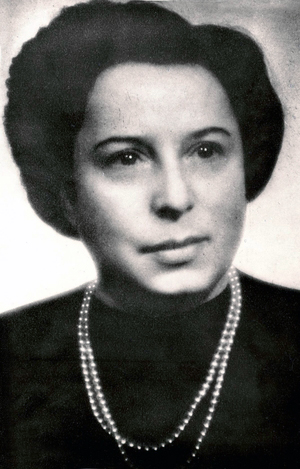
Gisi Fleischmann was a Zionist activist and the leader of the Bratislava Working Group, one of the best known Jewish rescue groups during the Holocaust. Fleischmann was arrested on 15 October 1944 and was murdered in the Auschwitz concentration camp three days later.

Kurt Ludwig Josef Maria Lingens was a German anti-fascist militant and physician. He and his wife, Ella Lingens, were honoured by Yad Vashem, which named them Righteous Among the Nations.
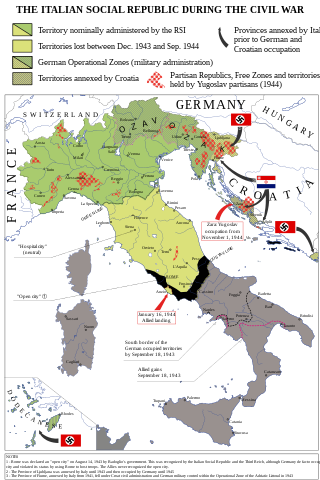
The Holocaust in Italy was the persecution, deportation, and murder of Jews between 1943 and 1945 in the Italian Social Republic, the part of the Kingdom of Italy occupied by Nazi Germany after the Italian surrender on 8 September 1943, during World War II.

Johanna Elsa Geissmar was a German-Jewish pediatrician murdered by the Nazi regime during the Holocaust. She was called Angel in Hell by the patients she helped during her stay in Gurs internment camp from October 1940 to August 1942.
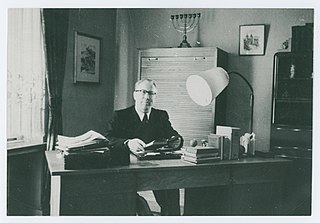
Friedrich Boßhammer (1906–1972) was a German jurist, SS-Sturmbannführer and close associate of Adolf Eichmann, responsible for the deportation of the Italian Jews to extermination camps from January 1944 until the end of the war in Europe. He was arrested in West Germany in 1968 and stood trial. Boßhammer was convicted and sentenced to life imprisonment in April 1972 for his involvement in the deportation of 3,300 Jews from Italy, but died before he could serve time in prison.
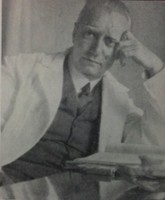
Karel František Koch was a Czech doctor known for rescuing Jews in Bratislava during the Holocaust. After the Communist takeover, he was jailed, but managed to escape the country shortly after the Warsaw Pact invasion of Czechoslovakia in 1968 and settled in Canada.
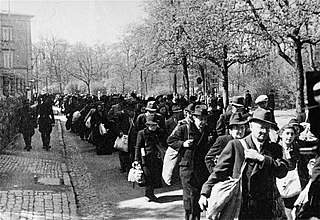
The question of how much Germans knew about the Holocaust while it was ongoing continues to be debated by historians. With regard to Nazi Germany, some historians argue that it was an open secret amongst the population, whilst others highlight a possibility that the German population were genuinely unaware of the Final Solution. Peter Longerich argues that the Holocaust was an open secret by early 1943, but some authors place it even earlier. However, after the war, many Germans claimed that they were ignorant of the crimes perpetrated by the Nazi regime, a claim associated with the stereotypical phrase "Davon haben wir nichts gewusst".

Ludwig Wörl, was a carpenter by profession. He was an opponent of Nazism, and as a result of his actions, was imprisoned in the Nazi concentration camps. He received the title of Righteous Among the Nations file #1 for rescuing Jews in concentration camps.
References
- ↑ "Spørreskjema for jøder i Norge, Berthold Epstein" [Questionnaire for Jews in Norway]. Oslo: Riksarkivet. 1942-03-04. Archived from the original on 2011-10-02.
- 1 2 Erlend Hem. "Jødiske pediatere på flukt" (in Norwegian). Tidsskriften for den norsle Lægeforening. Archived from the original on 2003-05-08. Retrieved 2008-01-17.
- ↑ Koren, Yehuda (2004). In Our Hearts We Were Giants: The Remarkable Story of the Lilliput Troupe-A Dwarf Family's Survival of the Holocaust. Da Capo Press. p. 92. ISBN 0-7867-1365-8.
- ↑ Lifton, Robert (1986). THE NAZI DOCTORS: Medical Killing and the Psychology of Genocide. pp. 296–297. ISBN 978-0465049042.
- ↑ "75 let nemocnice na Bulovce" [75 years of Bulovka Hospital] (in Czech). Prague. 2006. Archived from the original on 2013-12-17.